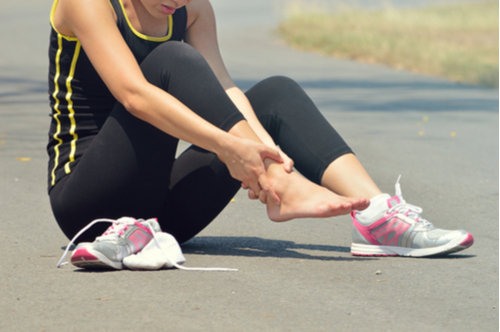
Every year in the U.S., there are an estimated 25,000 ankle injuries that occur daily. There are two types of ankle sprains that most commonly diagnosed based on the location of pain – High and Low ankle sprains. Typically, there are certain activities/sports as well as directions an ankle moves with excessive force that cause either a high or low ankle sprain. Is there a way that you can distinguish whether you’ve experienced a high or low ankle sprain? Below will be helpful information to help familiarize an individual who sprained their ankle to distinguish between the two. However, it is still highly recommended that you see a physical therapist who can perform a thorough evaluation for your ankle and prescribe a comprehensive home exercise program of appropriate strengthening, mobility, and stretches to help rehabilitate your injured ankle.
The most common ankle sprain for everyday recreational athletes and activities, the LOW ankle sprain. More specifically, the lateral ankle sprain (inversion sprain). The lateral ankle sprain is the most common orthopedic injury and accounts for 85% of all ankle injuries. Lateral ankle sprains typically occur when the foot is pointed down and rolls inward. This typically happens during soccer, football, and basketball with cutting/lateral movements. When a lateral ankle sprain occurs, it injures and stretches the ligaments on the outside aspect of the ankle. Common initial symptoms include swelling and pain with walking. A lateral ankle sprain will typically take anywhere from 2 weeks to 2 months to heal based on the severity. However, a severely sprained ligament with partial or full tearing can take up to 9 months to 1 year to heal. The severity of an injured ligament can be diagnosed as follows:
- Grade 1 – Mild, the ligament is overstretched
- Grade 2 – Moderate, the ligament is overstretched and partially torn
- Grade 3 – Severe, the ligament is completely torn
If you experience a lateral ankle sprain, it is important for them to initially P.R.I.C.E- Protect
- Rest
- Ice
- Compression
- Elevation
Set up an appointment to see your local physical therapist because recurrent ankle sprains are common. In fact, 73% of people who sprain their ankle once are likely to do so again. This is due to lack of muscle strength, stability, and balance that have not been restored to, or improved beyond, preinjury levels.
Another type of ankle sprain is the HIGH ankle sprain. High ankle sprains are more common in high impact sports, such as football and soccer. They usually occur when the ankle is turned outwards with your foot pointed upwards. This mechanism of injury (MOI) causes an injury to the four ligaments that help provide stability to the joint right above the ankle. Patients often report that they feel (1) pain above the ankle that increases when the foot rotates outwards, (2) pain with walking and significant bruising/swelling above the ankle. A high ankle sprain is a more serious ankle sprain compared to a low ankle sprain and as a result, it will be a longer rehabilitation process. Do NOT return to your normal recreational activity or sport if you experience the MOI and symptoms described above because this will place you at risk for further injury to the ligaments stabilizing the bones that make up your shin.
It is important to see a physical therapist who can assess and evaluate the integrity of the ligaments in the ankle. Physical Therapists’ are adept at observing and evaluating the body’s response to injury and how it affects the simplest of movements (i.e. walking/running pattern, squatting pattern, balance, etc). Your physical therapist will be able to come up with a specific plan of care to help you recover and be able to return to the activity/sport safely and pain-free. The goals of physical therapy for low and high ankle sprains is as follows:
- Injury Protection, Pain relief, and inflammation control
- Regain pain-free and full range of motion of the ankle
- Strengthen ankle, gastrocnemius, and hip musculature
- Restoration of balance and body’s ability to control ankle position
- Normalize normal walking pattern (pain-free)
- Normalize running pattern (pain-free)
- Plyometrics (jumping and landing with good body control)
- Speed and agility
- Activity or Sport-specific drills/training
- Return to activity/sport


